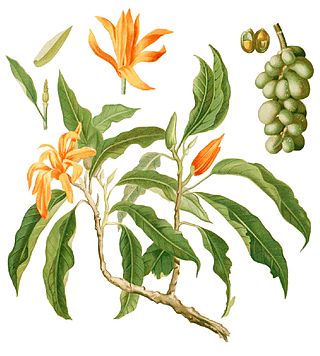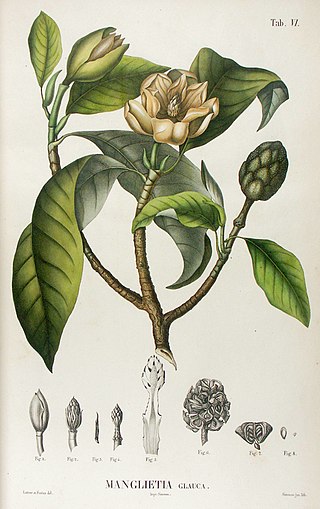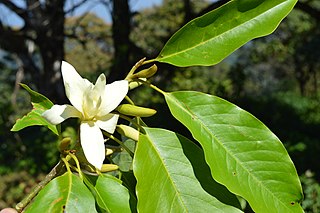
The Magnoliales are an order of flowering plants.

The Magnoliaceae are a flowering plant family, the magnolia family, in the order Magnoliales. It consists of two genera: Magnolia and Liriodendron.

Magnolia is a large genus of about 210 to 340 flowering plant species in the subfamily Magnolioideae of the family Magnoliaceae. It is named after the French botanist Pierre Magnol.

Liriodendron is a genus of two species of characteristically large trees, deciduous over most of their populations, in the magnolia family (Magnoliaceae).

Liriodendron tulipifera—known as the tulip tree, American tulip tree, tulipwood, tuliptree, tulip poplar, whitewood, fiddletree, lynn-tree, hickory-poplar, and yellow-poplar—is the North American representative of the two-species genus Liriodendron, and the tallest eastern hardwood. It is native to eastern North America from Southern Ontario and possibly southern Quebec to Illinois eastward to southwestern Massachusetts and Rhode Island, and south to central Florida and Louisiana. It can grow to more than 50 m (160 ft) in virgin cove forests of the Appalachian Mountains, often with no limbs until it reaches 25–30 m (80–100 ft) in height, making it a very valuable timber tree. The tallest individual at the present time (2021) is one called the Fork Ridge Tulip Tree at a secret location in the Great Smoky Mountains of North Carolina. Repeated measurements by laser and tape-drop have shown it to be 191 feet 10 inches (58.47 m) in height. This is the tallest known individual tree in eastern North America.

Magnolia virginiana, most commonly known as sweetbay magnolia, or merely sweetbay, is a member of the magnolia family, Magnoliaceae. It was the first magnolia to be scientifically described under modern rules of botanical nomenclature, and is the type species of the genus Magnolia; as Magnolia is also the type genus of all flowering plants (magnoliophytes), this species in a sense typifies all flowering plants.
Michelia is a historical genus of flowering plants belonging to the family Magnoliaceae. The genus included about 50 species of evergreen trees and shrubs, native to tropical and subtropical south and southeast Asia (Indomalaya), including southern China. Today it is regarded as a synonym of Magnolia.
Mammee may refer to several New World tropical fruits or the trees which produce these fruits:

Liriodendron chinense is Asia's native species in the genus Liriodendron. This native of central and southern China grows in the provinces of Anhui, Guangxi, Jiangsu, Fujian, Guizhou, Hubei, Hunan, Jiangxi, Shaanxi, Zhejiang, Sichuan and Yunnan, and also locally in northern Vietnam. Protected populations occur in the Tianmushan National Reserve, Huangshan, Wuyi Shan, and Badagongshan Nature Reserve.

Magnolia champaca, known in English as champak, is a large evergreen tree in the family Magnoliaceae. It was previously classified as Michelia champaca. It is known for its fragrant flowers, and its timber used in woodworking.

Manglietia was the name of a genus of flowering plants in the family Magnoliaceae, with about 40 Asian species listed. The genus is now considered a synonym of the well-known and similar Magnolia.
Magnolia dixonii is a species of flowering plant in the family Magnoliaceae. It is endemic to Ecuador. It is known commonly as cucharillo.

Magnolia sect. Talauma is a section of the genus Magnolia in the family Magnoliaceae. It was formerly treated as the separate genus Talauma. It contains only New World species, and is native to Mexico, Panama, Brazil, and the West Indies.
Magnolia neillii is a species of plant in the family Magnoliaceae. It is endemic to Ecuador. Its natural habitat is subtropical or tropical moist lowland forests. If the Magnolia family is treated as consisting of a large number of smaller genera, then this species is placed in genus Talauma. In modern literature, it is customary to treat Magnolia as one large genus, and in that case, this species is treated as belonging to section Talauma in subgenus Magnolia.

Magnolia × soulangeana, the saucer magnolia or sometimes the tulip tree, is a hybrid flowering plant in the genus Magnolia and family Magnoliaceae. It is a deciduous tree with large, early-blooming flowers in various shades of white, pink, and purple. It is one of the most commonly used magnolias in horticulture, being widely planted in the British Isles, especially in the south of England; and in the United States, especially the east and west coasts.

Magnolia × alba, also known as the white champaca, white sandalwood, or white jade orchid tree, is a flowering plant of hybrid origin that is commonly cultivated in Southeast Asia and tropical regions of East Asia. Although the exact origin is uncertain, it is considered to be a hybrid of Magnolia champaca and Magnolia montana.
James Edgar Dandy was a British botanist, Keeper of Botany at the British Museum between 1956 and 1966. He was a world specialist on the plant genus Potamogeton and the family Magnoliaceae.

Magnolia nilagirica is a species of plant in the family Magnoliaceae. It is a tree that is threatened by habitat loss, endemic to the Western Ghats of India, and also Sri Lanka.












